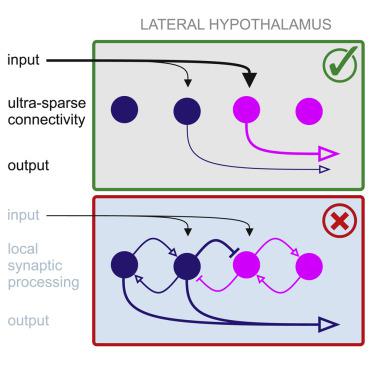Current Biology ( IF 8.1 ) Pub Date : 2020-08-20 , DOI: 10.1016/j.cub.2020.07.061 Denis Burdakov 1 , Mahesh M Karnani 2

|
The lateral hypothalamic area (LH) is a vital controller of arousal, feeding, and metabolism [1, 2], which integrates external and internal sensory information. Whereas sensory and whole-body output properties of LH cell populations have received much interest, their intrinsic synaptic organization has remained largely unstudied. Local inhibitory and excitatory connections could help integrate and filter sensory information and mutually inhibitory connections [3] could allow coordinating activity between LH cell types, some of which have mutually exclusive behavioral effects, such as LH VGLUT2 and VGAT neurons [4, 5, 6, 7] and orexin- (ORX) and melanin-concentrating hormone (MCH) neurons [8, 9, 10]. However, classical Golgi staining studies did not find interneurons with locally ramifying axons in the LH [11, 12], and nearby subthalamic and thalamic areas lack local synaptic connectivity [13, 14]. Studies with optogenetic circuit mapping within the LH have demonstrated only a minority of connections when a large pool of presynaptic neurons was activated [15, 16, 17, 18, 19]. Because multiple patch clamp has not been used to study LH connectivity, aside from a limited dataset of MCH neurons where no connections were discovered [15], we used quadruple whole-cell recordings to screen connectivity within the LH with standard methodology we previously used in the neocortex [20, 21, 22]. Finding a lack of local connectivity, we used optogenetic circuit mapping to study the strength of LH optogenetic responses and network oscillations, which were consistent with ultra-sparse intrinsic connectivity within the LH. These results suggest that input from other brain structures is decisive for selecting active populations in the LH.
中文翻译:

外侧下丘脑内的超稀疏连接。
下丘脑外侧区 (LH) 是唤醒、进食和新陈代谢的重要控制器 [1, 2],它整合外部和内部感觉信息。尽管 LH 细胞群的感觉和全身输出特性引起了广泛关注,但其内在的突触组织在很大程度上仍未得到研究。局部抑制性和兴奋性连接有助于整合和过滤感觉信息,而相互抑制性连接 [3] 可以协调 LH 细胞类型之间的活动,其中一些细胞具有相互排斥的行为效应,例如 LH VGLUT2 和 VGAT 神经元 [4, 5, 6 , 7] 以及食欲素 (ORX) 和黑色素浓缩激素 (MCH) 神经元 [8, 9, 10]。然而,经典的高尔基体染色研究并未发现 LH 中具有局部分支轴突的中间神经元 [11, 12],并且附近的丘脑底区和丘脑区域缺乏局部突触连接 [13, 14]。对 LH 内光遗传学电路图谱的研究表明,当大量突触前神经元被激活时,只有少数连接 [15,16,17,18,19]。由于多重膜片钳尚未用于研究 LH 连接性,除了未发现连接的 MCH 神经元的有限数据集之外 [15],我们使用四重全细胞记录来筛选 LH 内的连接性,并采用我们之前使用的标准方法。新皮质 [20,21,22]。发现缺乏局部连接,我们使用光遗传学电路映射来研究 LH 光遗传学反应和网络振荡的强度,这与 LH 内超稀疏的内在连接一致。这些结果表明,来自其他大脑结构的输入对于选择 LH 中的活跃群体具有决定性作用。





































 京公网安备 11010802027423号
京公网安备 11010802027423号